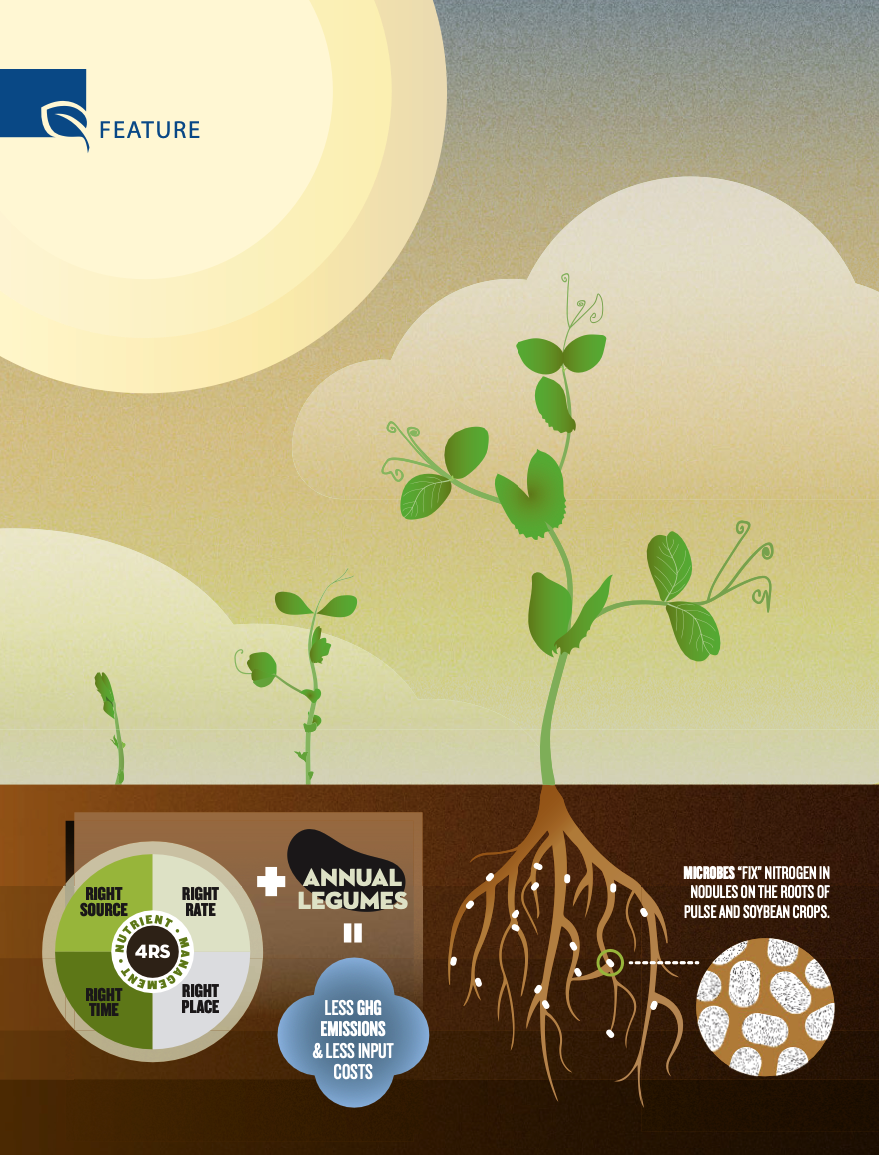Charley Sprenger, B.E., M.Sc., Project Leader Gary Bergen, P.Eng., Technical Lead | The Prairie Agricultural Machinery Institute (PAMI)
Annual legumes play a critical role in today’s low-carbon economy. The following two articles illustrate how introducing legumes into your crop rotation could mean lower input costs, greater environmental benefits, and increased profits.
Key Takeaways:
• Legumes have low greenhouse gas (GHG) emissions, especially nitrous oxide.
• This is because little to no nitrogen (N) fertilizer is required to produce legume crops (a large amount of GHG emissions is produced through the production, delivery, application of nitrogen fertilizers).
• GHG calculations take into account background emissions from the field in the form of nitrous oxide.
• Kristen MacMillan’s research at U of M indicates dry bean are better at sourcing their own N than previously thought.
• In PAMI’s analysis 60 – 70 lbs N / acre was used but if dry bean can source N on its own more effectively than we thought, then N might not need to be applied or maybe just at a lower rate… and then its GHG emissions will be lower.
THE GOAL OF this project was to provide information on the energy (fuel) use and greenhouse gas emissions generated from current management practices used for soybean, field pea, and dry bean production in Manitoba. This information was then used to assess potential changes farmers can implement to further reduce greenhouse gas emissions, and to determine areas that require further research and investment for the agricultural industry to increase energy use efficiency and carbon sequestration.
The sources used to estimate the energy use and greenhouse gas emission baselines for each crop included the Guide to Field Crop Production and Cost of Production
– Farm Machinery (Manitoba Agriculture), PAMI machinery analyses, extension publications, and scientific literature.
The on-and off-farm energy use and greenhouse gas emissions from the following sources were included:
•Production, delivery, and application of nutrient sources
• Decomposition of crop residues
• Nitrogen credits
• Machinery use for seedbed preparation and seeding, application of crop protection products, harvesting, residue management, and grain handling
A greater amount of greenhouse gas emissions was estimated for dry bean production compared to soybean and field pea production. This is because an application of 60–70 lbs acre-1 of actual nitrogen was included in the dry bean analysis and no nitrogen fertilizer was included in the soybean and field pea greenhouse gas calculations.

Reducing Greenhouse Gas Emissions and Carbon Sequestration
The majority of estimated greenhouse gas emissions associated with producing these crops are from the production, delivery, and application of synthetic nitrogen fertilizers. Including crop species in rotation that acquire nitrogen on their own, like field pea and soybean, will reduce overall greenhouse gas emissions on a farm. For soybean, the development of early maturing varieties that successfully complete their life cycle in Manitoba’s short growing environment has led to increased production of this crop and is promising for new environments where soybean production is uncommon. Additionally, new local field pea processing facilities have been developed highlighting the strong demand for this alternative source of protein.
The 4R fertilizer management practices should be followed if a nitrogen application is required to produce these crops. This involves applying nutrient sources at the right rate, source, timing, and placement, and begins with accurate soil testing and a nutrient management plan for each field. Farmers are encouraged to work with crop production advisors and agronomists with an accredited 4R designation to develop robust nutrient management plans for each field. These plans should be reviewed often.
The investigators of this project also noted the following technologies and management practices have strong potential to further reduce greenhouse gas emissions:
• Reduced, variable depth, strip, and prescribed tillage
• Automated guidance systems • Controlled traffic farming
• Alternative energy sources
Some of these technologies and management practices are already used by Manitoba farmers. Further research into alternative tillage strategies, particularly in cropping systems that manage high residue in often wet conditions like southern Manitoba, is encouraged. The development of alternative energy sources for farm machinery is well underway but requires more research and testing.


